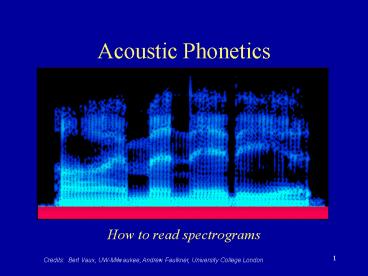Acoustic Phonetics How to read spectrograms - PowerPoint PPT Presentation
1 / 52
Title:
Acoustic Phonetics How to read spectrograms
Description:
Resonances of the vocal tract are called formants ... identified using formant structure (esp. F1 and F2) ... Approximants: vowel-like; formant movement. 46. IV. ... – PowerPoint PPT presentation
Number of Views:983
Avg rating:3.0/5.0
Title: Acoustic Phonetics How to read spectrograms
1
Acoustic PhoneticsHow to read spectrograms
Credits Bert Vaux, UW-Milwaukee Andrew
Faulkner, University College London
2
Acoustic Phonetics
- Spectrogram Basic
- Spectral Cues
- Vowels
- Consonants
- Continuous Speech
- Epilogue
3
I. Spectrogram Basics
4
Source-Filter Theory of Speech Production
Source
Filter
Speech
- Speech production can be divided into two
independent parts - Source of sound, such as the larynx
- Filters that modify the source, such as the vocal
tract
5
Spectrograms
Spectrograms of "hee" "ha" and "who".
6
Spectrograms
X-axis (horizontal) Time (milliseconds) Y-axis
(vertical) Frequency (Hertz) Z-axis (3-d
basically, coming right toward you) Amplitude
--gt amplitude corresponds to signal strength,
perceived as volume/loudness higher amplitudes
show up as darker marks on the spectrogram
7
Fundamental Frequency
- measure of vocal fold vibration (Hz)
- Hz hertz cycles per second
- Males 120 Hz
- Females 255 Hz
- Children 265 Hz
8
II. Spectral Cues
- Vowels
- Consonants
9
A. Vowels
- Produced with no significant constriction of oral
tract - Articulations change resonances of the vocal
tract - Moving the tongue, lips and jaw change the shape
of the vocal tract - Resonances of the vocal tract are called formants
- Changing the shape of the vocal tract changes the
- formant frequencies
10
Vowels Formants
11
Vowels Formants
12
Vowels Formants
13
Vocal Folds
14
The Vocal Folds in Action(very slow motion)
http//www.humnet.ucla.edu/humnet/linguistics/faci
liti/demos/demos.html
15
Fundamental Frequency
- measure of vocal fold vibration (Hz)
- Hz hertz cycles per second
- Males 120 Hz
- Females 255 Hz
- Children 265 Hz
16
Vowels Formants
17
B. Consonants
- Stops
- Voicing
- Aspiration
- Nasals
- Fricatives
- Voicing
- Approximants
- (liquids and glides)
18
1. Stops (e.g., /b/,/p/,/d/,/t/,/k/,/g/)
- Complete closure of the vocal tract
- Blocks flow of air through the oral cavity
- During voiced stops, only a voice bar can be
produced during the closure
19
Stops Voice Bar
idi
Voice Bar
20
Stops (e.g., /b/,/p/,/d/,/t/,/k/,/g/)
- Complete closure of the vocal tract
- Blocks flow of air through the oral cavity
- During voiced stops, only a voice bar can be
produced during the closure - Burst created at consonant release
- Created as closure is partially opened
- Frication noise created by blowing air through
partial opening - Very short duration
21
Stops Burst
idi
Burst
22
Stops Voicing
- Voiced Consonants
- Voicing starts less than about 30 ms after
release - Voicing can occur during closure
- Unvoiced Consonants
- Voicing starts more than about 50 ms after
release - Voicing cannot occur during closure
23
Stops Voicing
AtA vs. AdA?
24
Stops Voicing
AdA
AtA
25
Voicing and Aspiration
- Voiced Consonants
- Voicing starts less than about 30 ms after
release - Voicing can occur during closure
- Unvoiced Consonants
- Voicing starts more than about 50 ms after
release - Voicing cannot occur during closure
- Duration between release (i.e. burst) and start
of voicing is - called Voice Onset Time (VOT).
- long VOT gt aspiration
26
Stops Aspiration
AdA
AtHA
Aspiration
27
American English Aspiration
28
2. Nasals (e.g., /m/, /n/)
- Similar to voiced stops, except air also flows
through nasal cavity
- Velum controls airflow through nasal cavity
- Airflow allows voicing to continue during closure
- Stoppage of airflow in oral tract results in
decreased energy, characterized by nasal zeroes
(regions of extremely low energy)
29
Nasals
/ana/ vs. /ada/?
30
Nasals
ada
ana
31
3. Fricatives (e.g., /s/,/z/,/f/,/v/)
- Created by forcing air through a small
constriction - Noise is produced due to turbulence
32
Fricatives
afa
asa
33
Voiced Fricatives (e.g., /z/,/v/)
- Vocal folds can vibrate at the same time that
fricative energy is produced - Creates a voice bar during the fricative
34
Voiced vs. Voiceless Fricatives (1)
/T/ vs. /D/?
35
Voiced vs. Voiceless Fricatives (1)
aTa
aDa
36
Voiced Vs. Voiceless Fricatives (2)
37
Voiced Vs. Voiceless Fricatives (3)
38
Approximants (e.g., /l/,
/r/, /j/, /w/)
- More open constriction than for fricatives
- Free flow of air produces no turbulence
- Voicing continues during consonant
39
Approximants (e.g., /l/, /r/, /j/, /w/)
- More open constriction than for fricatives
- Free flow of air produces no turbulence
- Voicing continues during consonant
- Similar to vowels
- Approximants have lower F1 than for vowels
- Glides tend to have more formant movement than
vowels
40
Approximants
awa
41
Continuous Speech
42
Continuous Speech
Im an idiot
43
Continuous Speech
ajm n Idijt
44
Continuous Speech, Segmented
a
a
45
Summary of Spectral Cues
- Vowels (open oral tract)
- identified using formant structure (esp. F1 and
F2) - Consonants (differing degrees of constriction in
the oral tract) - Stops stoppage of air voice bar aspiration
- Nasals vowel-like, with nasal zeros
- Fricatives noise
- Approximants vowel-like formant movement
46
IV. Epilogue
47
Broad vs. Narrow Transcription
lta teegt lta rheegt
Broad tij rij
Narrow tHij rij
48
Broad vs. Narrow Transcription
lta teegt lta treegt lta churchgt
Broad tij trij
tSrtS
Narrow tHij tSrij
tSrtS
49
l "clean" vs. "lean"
50
l "clean" vs. "lean"
klijn
lijn
51
"Stoughton"
52
"Stoughton"
stHo?n
stHow?n































